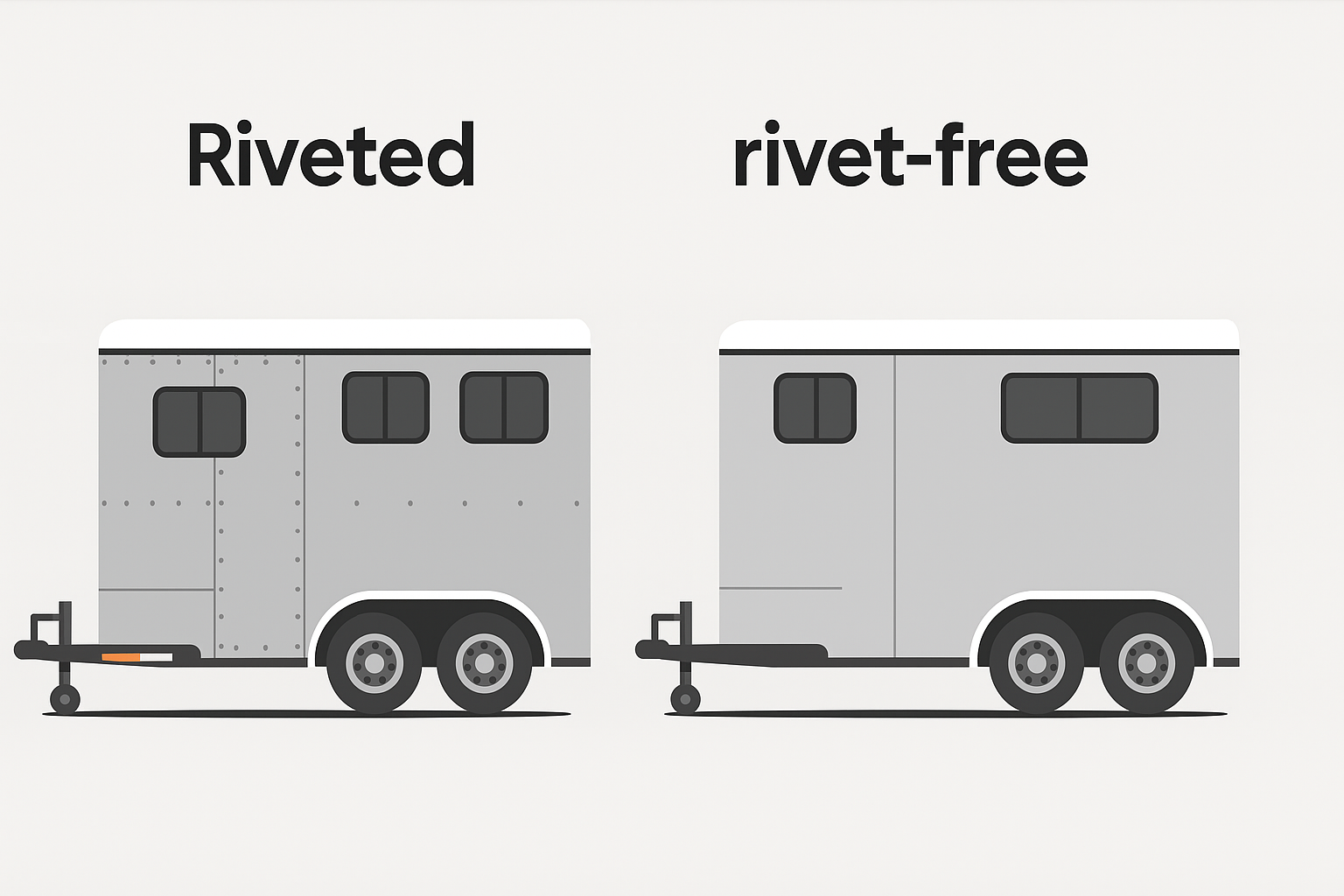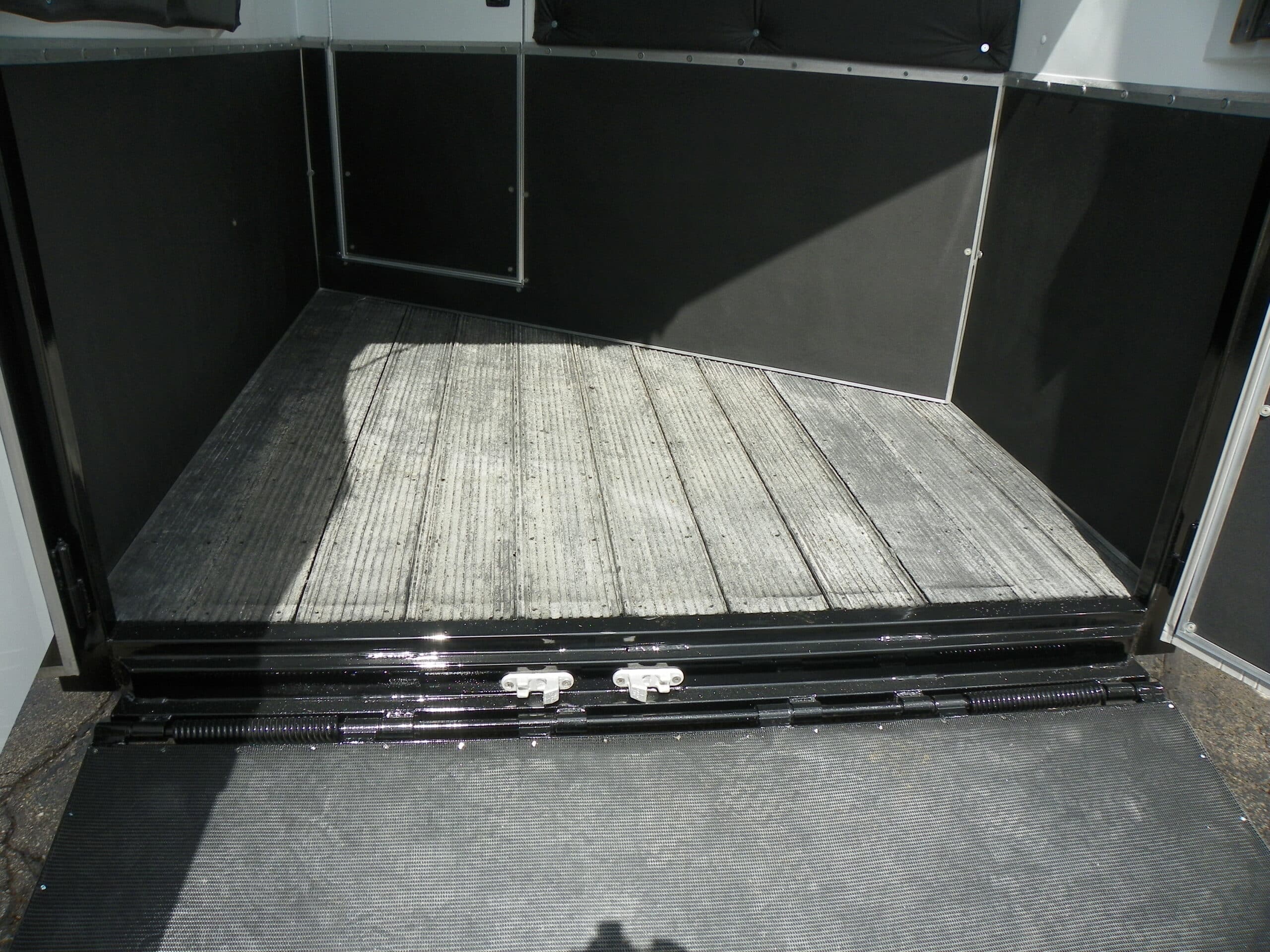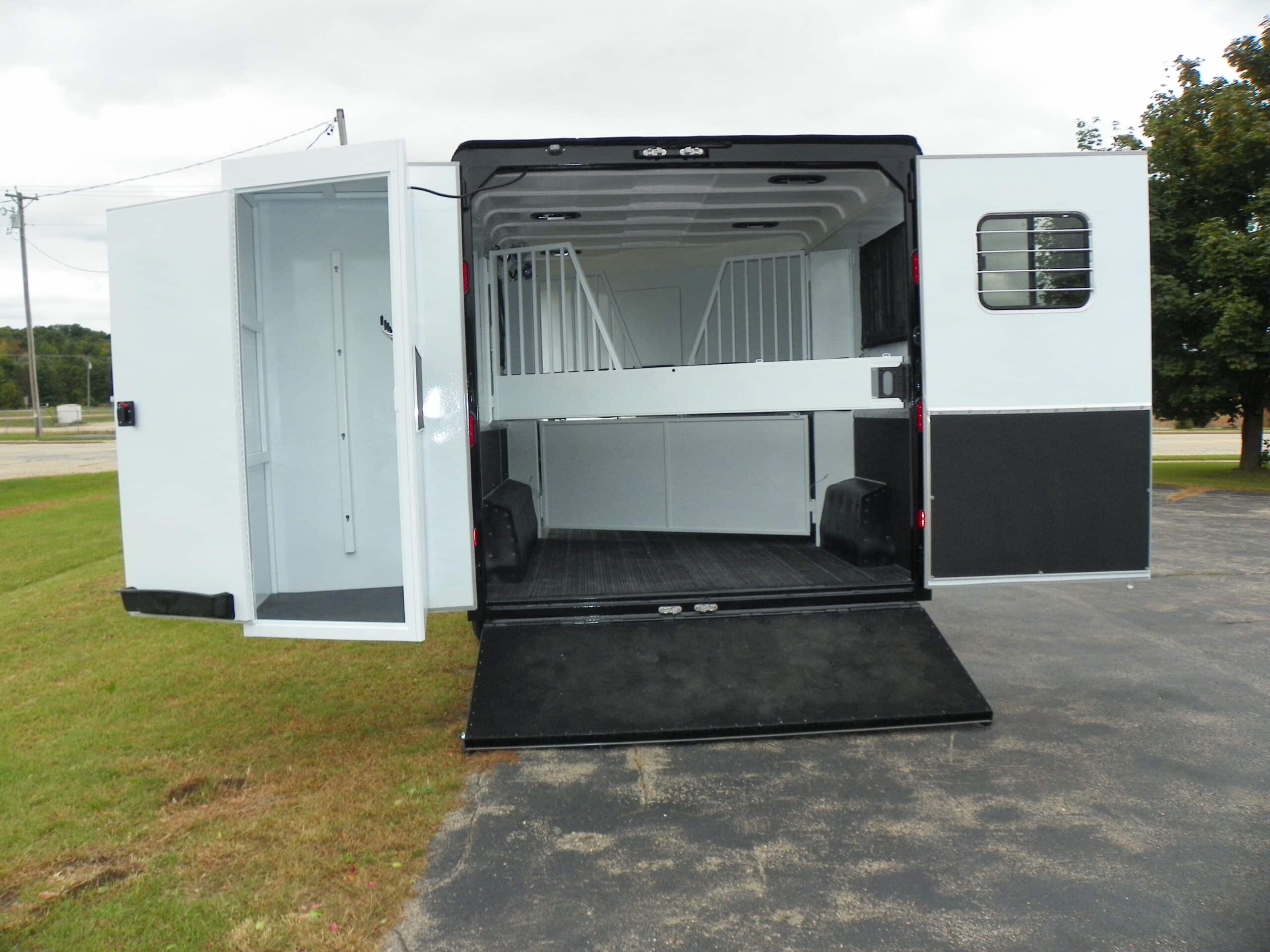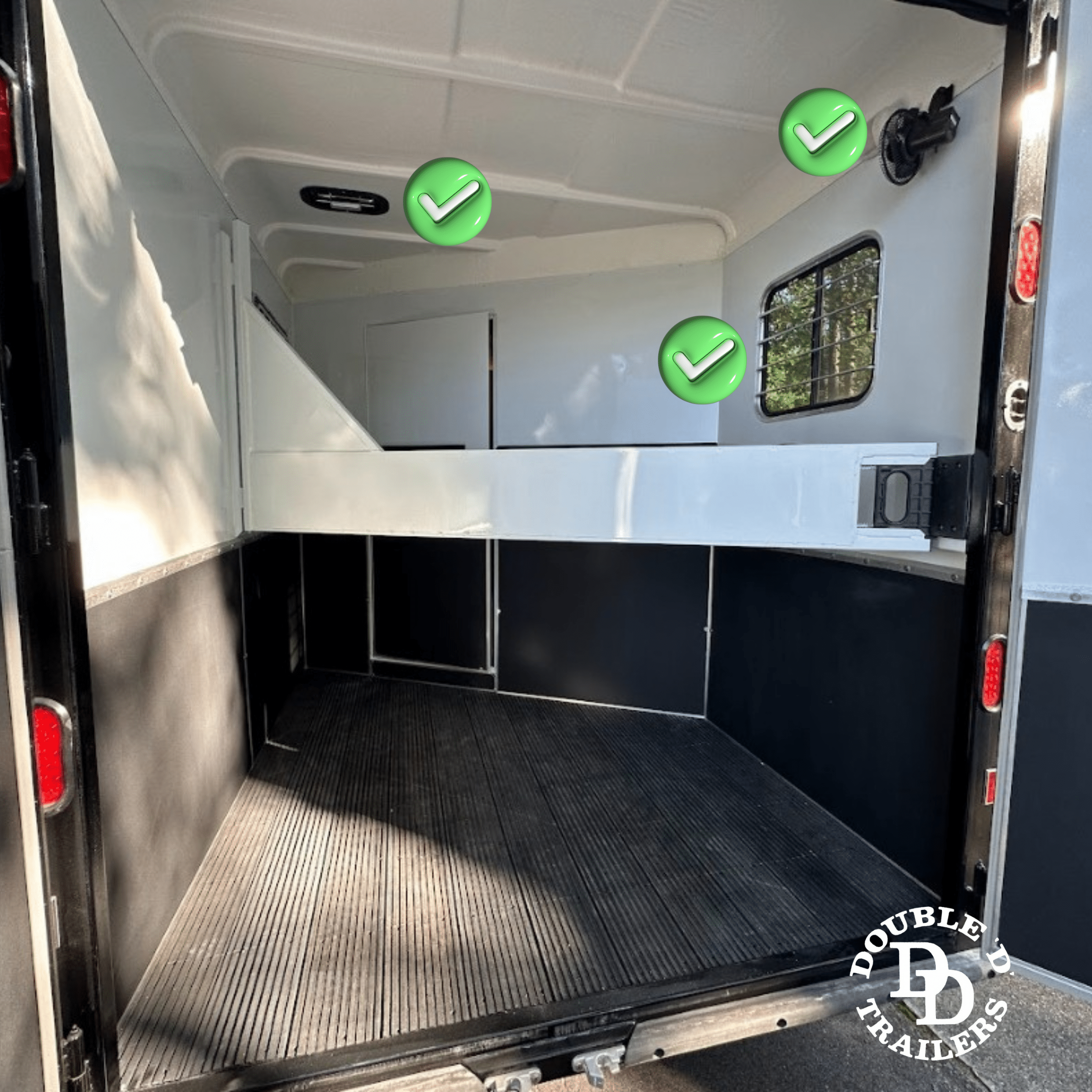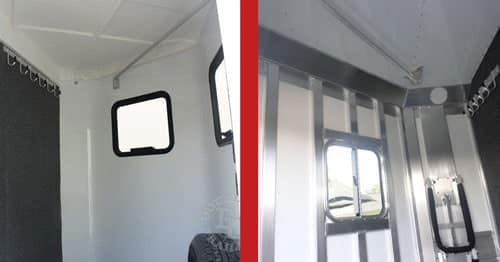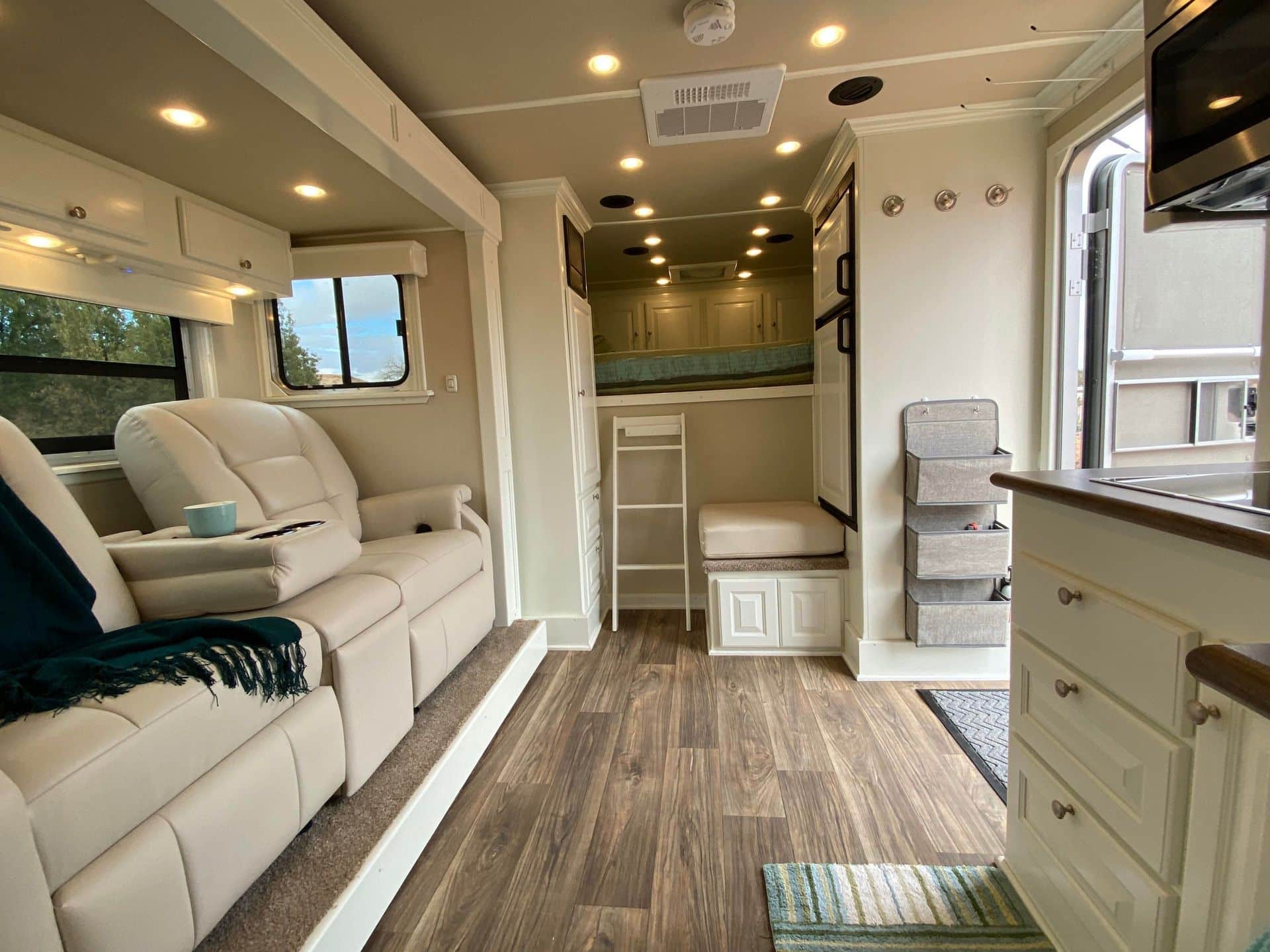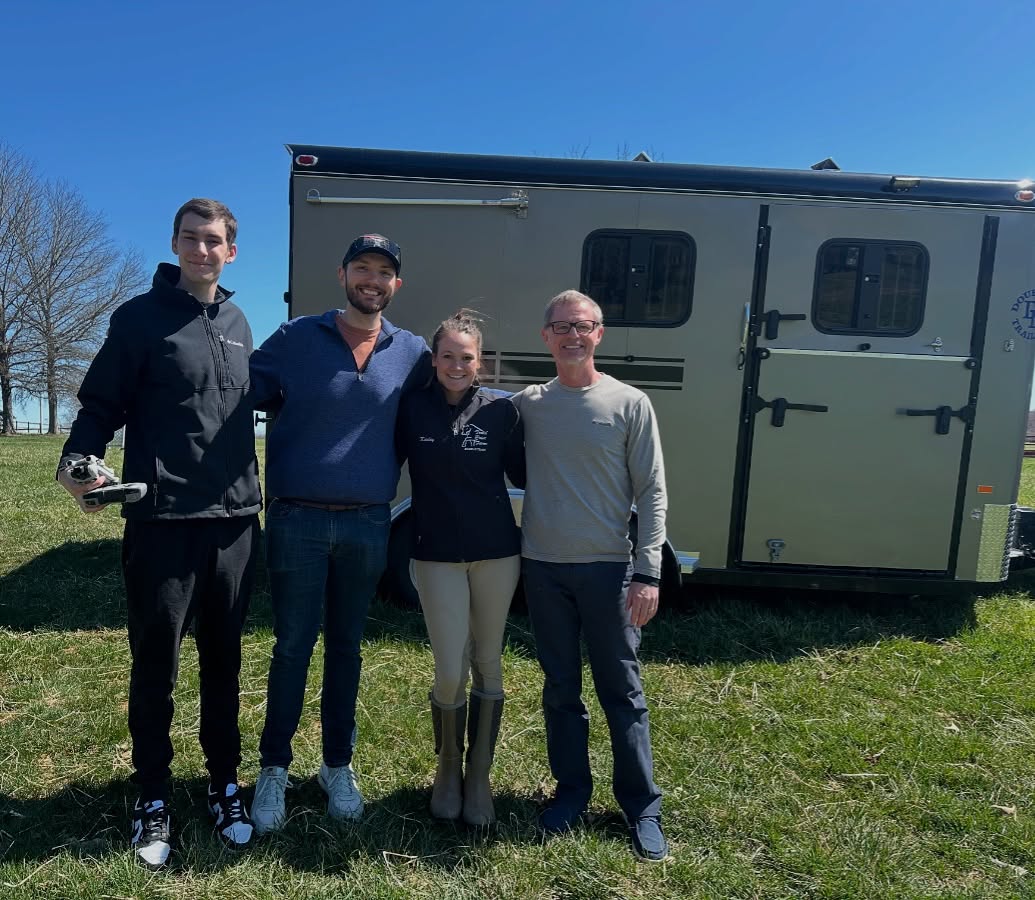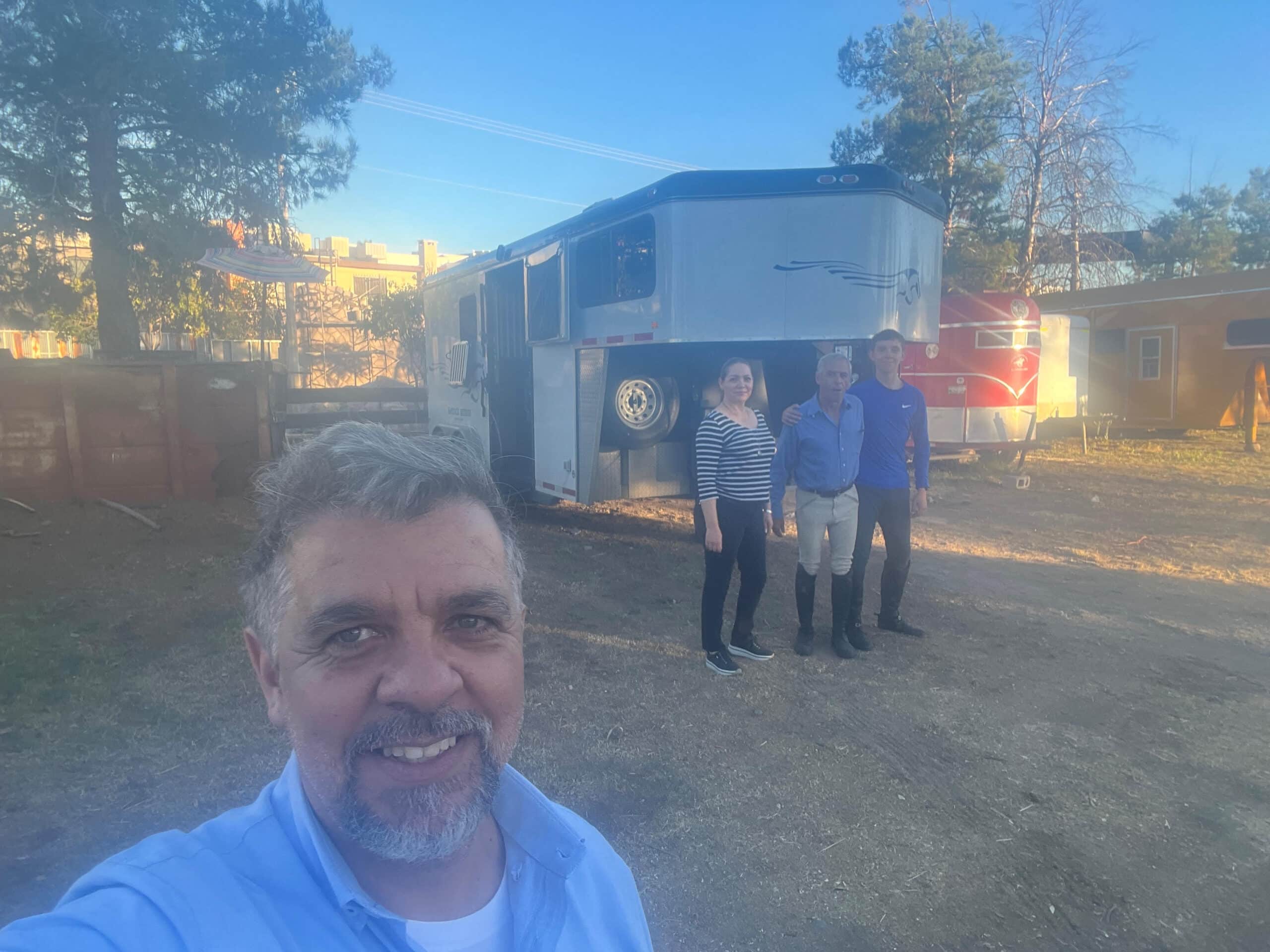Horse Trailer Features That Actually Matter | Compare 9 Top Brands
Let’s be honest: Most horse owners don’t get a second chance at buying the right trailer.
And when you’re trying to protect a 1,200 lb animal on wheels — you can’t afford to guess.
That’s why this guide doesn’t start with “Which brand is best?”
It starts with what actually matters:
- How walls are constructed
- What fasteners are used
- Whether the roof is one seamless piece or stitched together
- If the flooring will rot in 5 years... or 25
- Whether your horse loads calmly — or not at all
This isn’t a brand battle. It’s a blueprint for making confident, horse-first decisions. And once you know what to look for, we’ll show you how today’s top trailer brands stack up on the features that count.
Wall & Frame Construction
Why it matters: The materials behind the walls directly affect your horse’s safety, comfort, and long-term durability. Aluminum may be lightweight, but it can crack under stress. Steel is strong, but heavy and rust-prone. Look for frames that balance strength, weight, and corrosion resistance.
What to look for:
- Tubular wall posts
- Galvalite or corrosion-resistant skins
- No exposed steel
🛠️ Did You Know? — Wall & Frame Construction
Most horse trailers are built with either tubular steel or aluminum framing, but not all frames are created equal. At Double D Trailers, we use Z-Frame Technology — a safer, stronger, and rust-resistant alternative to conventional steel that rivals aluminum in weight but outperforms it in strength. This means superior protection for your horse without compromising on towability or durability.
Many trailers use what's called a hat channel wall post — a thin, lightweight support shaped like a flattened hat. These posts can save weight, but they often reduce interior strength and limit insulation coverage. By contrast, our trailers use fully enclosed tubular wall posts — think of it like using a solid beam instead of a hollow bracket. The result? A stronger frame, more even insulation, and better protection for your horse in the event of impact.
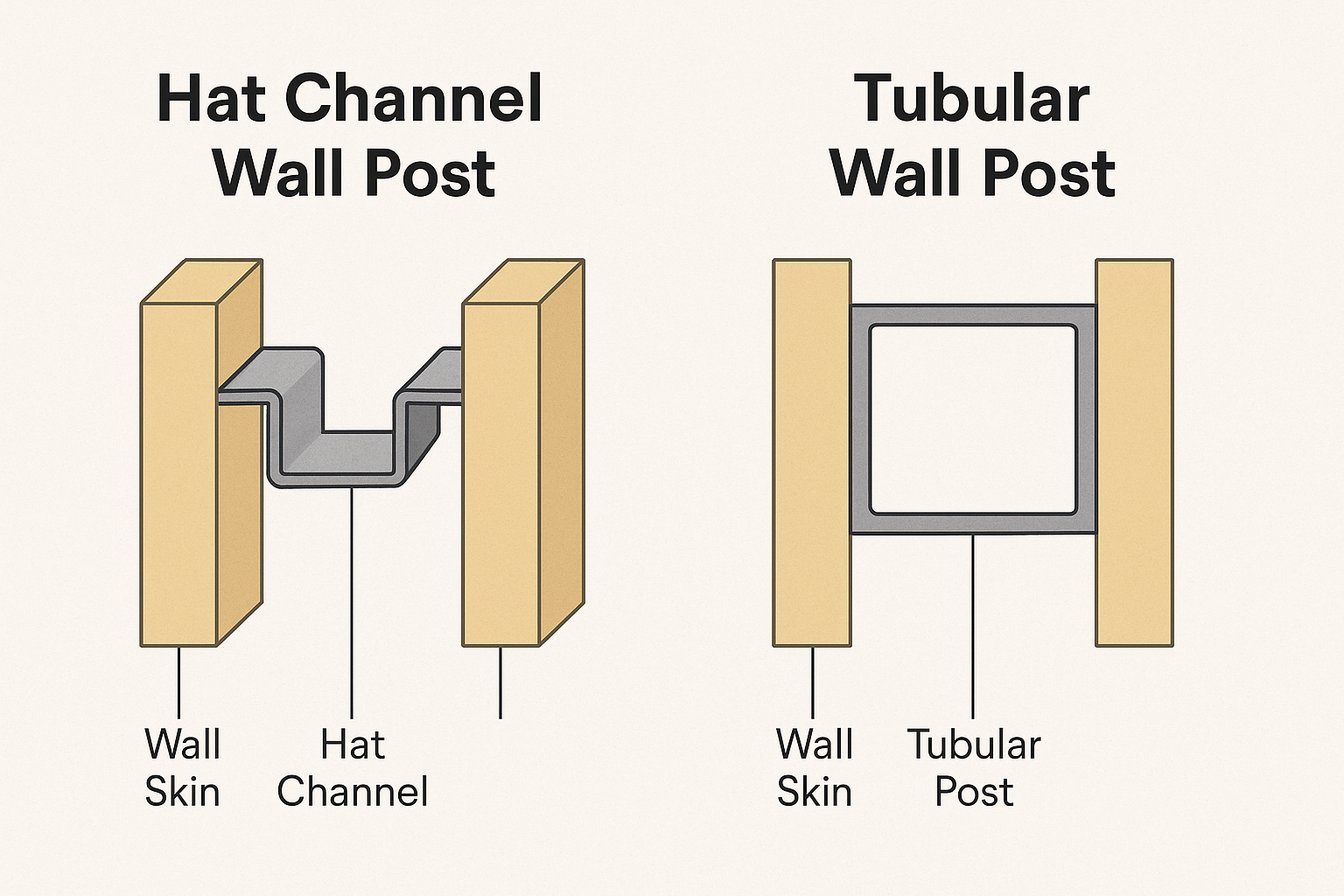
What Each Brand Uses for Wall & Frame Construction
The chart below outlines the wall and frame materials used by leading horse trailer manufacturers. This is not a ranking — it’s a reference to help you compare specs and ask the right questions while shopping.
| Brand | Frame Material | Wall Posts | Skin/Panel Material | Corrosion Resistance |
|---|---|---|---|---|
| Double D Trailers | Z-Frame® (Zinc-infused alloy). Strong like steel, Lightweight like aluminum |
Tubular | Galvalite® Skin interior Aluminum exterior |
✓ |
| Featherlite | Aluminum NOTE: Aluminum doesn't perform well in a high stress environment such as a rear end collision or spooked horse. |
Hat Channel | Aluminum Sheets | ✓ |
| Sundowner | Aluminum or Steel | Tubular | Aluminum Sheets | Varies by model |
| 4-Star | Aluminum | Tubular | Aluminum Sheets | ✓ |
| Cimarron | Aluminum | Tubular | Aluminum Sheets | ✓ |
| Lakota | Aluminum | Hat Channel | Aluminum Sheets | ✓ |
| Shadow | Aluminum | Tubular | Aluminum Sheets | ✓ |
| Bloomer | Aluminum | Tubular | Aluminum Sheets | ✓ |
| Exiss | Aluminum | Hat Channel | Aluminum Sheets | ✓ |
Data compiled from manufacturer websites and brochures as of May 2025. Always confirm with the brand for the latest specs.
Read more about our trailer construction standards or learn about the dangers of all-aluminum trailers before you buy.
Fasteners & Joinery
Why it matters: Screws loosen. Welds crack. And rivets can vibrate out. Poor fasteners lead to noisy, unstable rides. Bonded walls with minimal seams reduce long-term wear and stress on your trailer — and your horse.
What to look for:
- Bonded wall panels (no visible rivets)
- Structural adhesive in key stress points
🔩 Did You Know? — Fasteners
What holds your trailer together matters. Many manufacturers rely on self-tapping screws, which can loosen or rust over time. At Double D Trailers, we use mechanically fastened and sealed rivets or bolts for added structural integrity and long-term durability. That means fewer squeaks, fewer leaks, and more reliability on every haul.
What Each Brand Uses for Fasteners & Joinery
The chart below outlines how each brand approaches the structural connections that hold the trailer together. This includes fastener types, bonding methods, and whether panels are fully welded or mechanically attached.
| Brand | Wall Panel Bonding | Use of Screws or Rivets | Welded Frame Joints |
|---|---|---|---|
| Double D Trailers | Structural Adhesive Bonding | Minimal, only where needed | ✓ |
| Featherlite | Mechanical Fasteners (Rivets) | Extensive Rivets | Spot Welds |
| Sundowner | Mostly Screws & Rivets | ✓ | ✓ |
| 4-Star | Structural Adhesive Bonding | ✓ | ✓ |
| Cimarron | Bonded Skin + Rivets | ✓ | ✓ |
| Lakota | Primarily Screws | ✓ | ✓ |
| Shadow | Mechanical Fasteners | ✓ | ✓ |
| Bloomer | Rivets & Adhesives | ✓ | ✓ |
| Exiss | Rivets + Screws | ✓ | ✓ |
Data compiled from manufacturer websites and brochures as of May 2025. Always confirm with the brand for the latest specs.
It's what holds the trailer together — literally. See why fastener type matters and how our method improves longevity and safety.
🏗️ Roof Design
Your trailer’s roof plays a critical role in temperature regulation, leak prevention, and head safety. A seamless roof is quieter, stronger, and better at deflecting heat — which makes a real difference on long hauls.
Why it matters: Many trailer roofs are described as “one-piece,” but here’s what that often means: a single aluminum sheet fastened to the frame using screws or rivets. While technically a single panel, those fasteners create seams at every attachment point — seams that can leak, rattle, and flex over time.
At Double D Trailers, we take a different approach. Our SafeBump® roof is molded as a single composite structure — no seams, no fasteners, and no exposed hardware on the top. This not only prevents leaks but also deflects heat, insulates the trailer interior, and cushions your horse’s head if they rear up.
What to look for:
- Molded roof with no attachment seams
- High heat reflection
- Impact absorption
- No exposed rivets or caulking strips
Note: Many brands advertise “seamless” roofs, but most are aluminum sheets riveted to the top rails — creating exposed seams along both sides.
🏗️ Did You Know? — Roof Structure
While many trailers use a thin aluminum sheet on the roof, Double D Trailers features a one-piece leak-resistant fiber composite roof. It’s not only tougher — with no seams to split — but it also reflects heat far better than traditional materials. That means cooler temperatures inside and more comfort for your horse during summer hauls.
What Each Brand Uses for Roof Construction
The chart below compares how each brand approaches roof design — from materials to structure. Use it as a guide to ask better questions and find the setup that’s safest for your horse.
| Brand | Roof Type | Seamless? | Insulated? |
|---|---|---|---|
| Double D Trailers | SafeBump® Composite Roof | ✓ (one-piece molded) | ✓ |
| Featherlite | Aluminum Roof with Seam around the entire roof Perimeter |
✕ | Optional |
| Sundowner | Aluminum Roof with Seam around the entire roof Perimeter |
✕ | Optional |
| 4-Star | Aluminum Roof with Seam around the entire roof Perimeter |
✕ | Optional |
| Cimarron | Aluminum Roof with Seam around the entire roof Perimeter |
✕ | Optional |
| Lakota | Aluminum Roof with Seam around the entire roof Perimeter |
✕ | Optional |
| Shadow | Aluminum Roof with Seam around the entire roof Perimeter |
✕ | Optional |
| Bloomer | Aluminum Roof with Seam around the entire roof Perimeter |
✕ | Optional |
| Exiss | Aluminum Roof with Seam around the entire roof Perimeter |
✕ | Optional |
Data compiled from manufacturer websites and brochures as of May 2025. Always confirm with the brand for the latest specs and model variations.
Curious to know what makes a roof truly horse-friendly? Explore the benefits of our SafeBump® roofing system and see how it compares to standard aluminum designs.
Flooring Materials
Why it matters: A weak or poorly designed floor is more than an inconvenience — it’s a safety risk. Your horse’s comfort, joint health, and even ability to stand securely while hauling depend on a stable, durable surface. And once urine and water enter the equation, rot and rust can follow fast.
What to look for:
- Rot-proof or sealed flooring (composite or treated aluminum)
- Non-slip texture — even when wet
- Drainage or airflow beneath mats
🪵 Did You Know? — Trailer Flooring
Wood, aluminum, and even plastic composite — there are lots of flooring options out there. But Rumber® flooring, used in Double D Trailers, stands apart. It’s made from recycled rubber and plastic, offering incredible grip, zero maintenance, and no need for mats. It’s slip-resistant, rot-proof, and easy on hooves — a better footing for your horse and peace of mind for you.
What Each Brand Uses for Flooring
This chart outlines the flooring material used by top trailer brands, as well as options for upgrades or drainage. Some materials offer durability but can be slick when wet, while others require careful maintenance to prevent corrosion or rot.
| Brand | Floor Material | Rot-Proof? | Drainage or Airflow |
|---|---|---|---|
| Double D Trailers | Pressure-treated wood or optional Rumber® | ✓ (Rumber option) | ✓ (built-in drainage under mats) |
| Featherlite | Aluminum with rubber mats | ✓ (but can corrode under mats) | ✕ |
| Sundowner | Aluminum or treated wood (varies) | Varies by model | ✕ |
| 4-Star | Aluminum with mats | ✓ (corrosion-prone if unsealed) | ✕ |
| Cimarron | Aluminum extruded floor | ✓ | ✓ (airflow through channels) |
| Lakota | Aluminum with mats | ✓ (requires maintenance) | ✕ |
| Shadow | Aluminum or wood composite | ✓ (wood composite version) | ✕ |
| Bloomer | Aluminum with rubber mats | ✓ (monitor for corrosion) | ✕ |
| Exiss | Aluminum | ✓ | ✕ |
Data compiled from manufacturer websites and brochures as of May 2025. Flooring features may vary by model and options selected.
Want to know why Rumber floors are a better choice? Learn how they compare to wood and aluminum with mats and what that means for long-term comfort and safety.
📘 Want to Go Deeper?
Brad Heath’s book, The Honest-to-Goodness Truth About Horse Trailers, reveals the behind-the-scenes truths about trailer design that manufacturers don’t always want you to know. It’s the ultimate guide for horse owners who want to buy smart, stay safe, and protect their investment.
Tack & Loading Design
Why it matters: Loading can be one of the most stressful parts of trailering — for both horse and handler. A well-designed tack layout can reduce anxiety, prevent injuries, and speed up your routine. Walk-on/walk-off systems are often safer than backing out, especially with young or nervous horses.
What to look for:
- Walk-on/walk-off or side ramp configuration
- Rear tack that doesn’t block loading space
- Swing-out tack storage (for easier access and safety)
🐴 Did You Know? — Tack & Loading Design
Traditional rear tack doors can block the loading space and intimidate horses. Our patented SafeTack® design swings completely out of the way, offering a full-width rear opening for safer and easier loading. Combined with reverse-angle stall options, our trailers reduce stress for hard-to-load horses and increase safety for handlers.
What Each Brand Offers for Tack & Loading
This chart shows how different manufacturers approach tack layout and loading flow. Design can vary widely between models — so always confirm how a trailer is configured before purchasing.
| Brand | Rear Tack Type | Walk on walk off configuration | Swing-Out Tack? |
|---|---|---|---|
| Double D Trailers | SafeTack® Swing-Out Compartment | ✓ (standard) | ✓ |
| Featherlite | Collapsible Rear Tack | Optional | ✕ |
| Sundowner | Collapsible Rear Tack | Optional | ✕ |
| 4-Star | Collapsible Rear Tack | Optional | ✕ |
| Cimarron | Collapsible Rear Tack | Optional | ✕ |
| Lakota | Fixed Rear Tack or collapse style | Optional | ✕ |
| Shadow | Collapsible Rear Tack | Optional | ✕ |
| Bloomer | Fixed or Collapsible Rear Tack | Optional | ✕ |
| Exiss | Fixed Rear Tack or collapse style | Optional | ✕ |
Data compiled from manufacturer websites and brochures as of May 2025. Always confirm tack layout and ramp configuration on your specific model.
Loading struggles? You’re not alone. Discover how the SafeTack® system changes the game for hard-to-load horses.
Ventilation & Airflow
Why it matters: Horses are sensitive to heat, humidity, and poor airflow. Good ventilation reduces stress, regulates temperature, and minimizes respiratory issues. Some trailer designs look great on the outside but trap hot, stagnant air inside — especially on long hauls.
What to look for:
- Windows on head and hip side (with screens)
- Roof vents above each stall
- Insulated walls and ceiling
🌬️ Did You Know? — Ventilation & Airflow
Poor airflow is a hidden danger in many horse trailers. At Double D Trailers, we design each trailer with a custom airflow system that includes strategically positioned windows and roof vents to keep fresh air moving. The result? A trailer that helps prevent respiratory issues, reduces heat stress, and promotes overall horse health.
What Each Brand Offers for Ventilation
This chart outlines how leading trailer brands approach airflow and ventilation. Look for both natural air movement (from windows and vents) and heat regulation (from insulation).
| Brand | Roof Vents per Stall | Head & Hip Windows | Insulated Walls/Roof |
|---|---|---|---|
| Double D Trailers | ✓ (1 per stall on forward facing, 2 per stall on reverse loads) |
✓ (drop-downs + bars) | ✓ (standard front to rear) |
| Featherlite | Optional | ✓ (sliders) | Optional |
| Sundowner | ✓ (varies by model) | ✓ (sliders) | Optional |
| 4-Star | ✓ | ✓ | Optional |
| Cimarron | ✓ | ✓ | Optional |
| Lakota | ✓ | ✓ | Optional |
| Shadow | Optional | ✓ (sliders) | Optional |
| Bloomer | ✓ | ✓ | ✓ |
| Exiss | Optional | ✓ | Optional |
Ventilation features may vary by trim level or custom order. Confirm all airflow and insulation options when specifying your trailer.
Proper ventilation isn’t just about windows — it’s about smart design. Learn how airflow affects horse health and comfort inside the trailer.
Insulation
When you picture a horse trailer, you probably think about the frame, the axles, or the living quarters — but rarely what’s between the walls. That’s a mistake.
Proper insulation doesn’t just help with temperature regulation — it can dramatically reduce stress and protect your horse’s health on every haul.
Why it matters: Horses are incredibly sensitive to temperature swings, noise, and humidity. Trailers that lack full insulation can turn into ovens in the summer and fridges in the winter — and worse, the noise from metal walls can cause anxiety, restlessness, and even injury. Double D Trailers are fully insulated in both the roof and sidewalls — using SafeBump technology in the ceiling and insulated panels in the horse area — helping to maintain a more stable and quiet interior environment.
What to look for:
- Insulated roof
- Insulated sidewalls in the horse area
- Seam-free panels
- Ventilation + insulation combo (Insulation is only effective when paired with smart airflow.)
❄️ Did You Know? — Insulation
Not all trailers are insulated — and even fewer are insulated correctly. At Double D Trailers, we use SafeBump insulated roofing and fully insulated sidewalls. This not only keeps the heat out in the summer and the cold out in the winter, but it also helps control noise, making your horse’s ride less stressful.
That’s a quieter, safer, more comfortable journey every time — no matter the weather or road conditions.
Learn how insulation impacts both heat and noise inside the trailer. Read about our full insulation approach »
Insulation Comparison Chart (Horse Area)
| Brand | Roof Insulation | Sidewall Insulation | Noise Dampening |
|---|---|---|---|
| Double D Trailers | ✔ SafeBump™ insulated composite roof | ✔ Fully insulated horse area walls | ✔ Yes – padded walls reduce vibration and echo |
| Featherlite | ✖ Bare aluminum roof (no insulation standard) | ✖ No insulation in horse area | ✖ No noise reduction features |
| Sundowner | △ Optional insulated roof upgrade | △ Horse area insulation optional | ✖ Minimal sound dampening unless upgraded |
| 4-Star | △ Spray foam insulation available on request | △ Optional foam sidewall insulation | △ Moderate noise control if insulated |
| Bloomer | ✔ Roof insulation in most models | △ Some sidewall insulation in horse area | △ Partial noise control (varies) |
| Logan Coach | ✔ Roof insulation in most models | ✔ Vortex-coated walls with insulation layer | ✔ Decent vibration dampening |
| Bison | ✖ Typically uninsulated roof | ✖ No standard horse area insulation | ✖ Loud interior with metal echo |
| Exiss | ✖ Bare aluminum roof (upgrade available) | ✖ Uninsulated horse area standard | ✖ No noise control |
| Lakota | △ Roof insulation in LQ models only | ✖ Horse area often uninsulated | ✖ Echo-prone in horse area |
This comparison is based on publicly available manufacturer specs, dealer listings, and customer feedback as of the time of publication. Features may vary by model or trim level. Always confirm directly with the brand before purchase.
Living Quarters & Customization
Why it matters: Whether you’re camping, showing, or just need a place to nap between classes, comfort matters. But so does weight distribution, layout, and usable space.
What to look for:
- Available living quarters (LQ) packages: basic to luxury
- Stall sizing that fits tall or wide horses (including warmbloods)
- Layout flexibility: add ramps, adjust stall orientation, or simplify
🏡 Did You Know? — Living Quarters & Customization
No two riders are the same — so why settle for cookie-cutter living quarters? Every Double D Trailer is built-to-order with customizable LQ layouts, finishes, storage, and horse area features. From weekenders to full LQs, we design with your needs in mind, ensuring comfort, convenience, and smart space usage.
What Each Brand Offers for LQ & Customization
This chart outlines the level of customization and living quarters options each brand supports. Use this to weigh flexibility and fit — not just furniture or finishes.
| Brand | Full Living Quarters Available? | Stall Size Customization | Layout Flexibility |
|---|---|---|---|
| Double D Trailers | ✓ (LQ or simple dress room) | ✓ (built-to-fit, including warmbloods) | ✓ (side ramp, rear ramp, reverse slant, etc.) |
| Featherlite | ✓ | Limited | Some options |
| Sundowner | ✓ | Optional upgrades | Moderate |
| 4-Star | ✓ | ✓ (wide range) | ✓ |
| Cimarron | ✓ | ✓ (varies by dealer) | ✓ |
| Lakota | ✓ (emphasis on LQ) | Standard options | Limited (LQ-focused) |
| Shadow | ✓ | Limited | Some options |
| Bloomer | ✓ (premium LQ) | ✓ (luxury focus) | ✓ |
| Exiss | ✓ | Standard | Some options |
Living quarters availability and customization levels may vary by dealer or region. Always confirm specs before finalizing your trailer design.
Thinking about living quarters? Explore custom layout options and finishes that fit your travel and riding lifestyle.
Warranty & Support
Why it matters: Even the best-built trailer can have issues over time. A good warranty isn’t just about years on paper — it’s about how easily you can get help when you need it, and whether the support team actually stands behind what they build.
What to look for:
- Clear written warranty (lifetime, structural, or full trailer)
- Direct factory support vs. dealer-only
- Nationwide service or mobile repair options
🛡️ Did You Know? — Warranty & Support
A trailer is a big investment — and your peace of mind shouldn’t end at delivery. That’s why we back our trailers with a strong warranty and lifetime support. From answering questions to helping with parts years down the road, we stand by our product — and our customers.
What Each Brand Offers for Warranty & Support
This chart breaks down how different trailer brands handle support and warranty terms. Consider not just the years, but how easy it is to get parts, answers, and repairs when needed.
| Brand | Structural Warranty | Support Contact | Repairs Handled By |
|---|---|---|---|
| Double D Trailers | 3 year non-structural components lifetime on frame |
Direct to Factory | Nationwide Mobile Techs or Local Shops |
| Featherlite | 3 year non-structural components 10 Years Structural |
Dealer First | Authorized Dealers |
| Sundowner | 2 year non-structural components 8 Years Structural |
Dealer First | Authorized Dealers |
| 4-Star | 2 year non-structural components 8 Years Structural |
Dealer First | Authorized Dealers |
| Cimarron | 3 year non-structural components 8 Years Structural |
Factory or Dealer | Dealer Network |
| Lakota | 1 year hitch to bumper 6 Years Structural max, some models less |
Dealer First | Authorized Dealers |
| Shadow | Unlisted on non-structural components, more than likely only one year 7 Years Structural |
Dealer First | Dealer Network |
| Bloomer | Unlisted on non-structural components, more than likely only 1 year 10 Years Structural |
Dealer or Factory | Dealer or Factory Shop |
| Exiss | 3 year non-structural components 8 Years Structural |
Dealer First | Dealer Network |
Warranty and service terms may vary by dealer. Always request the full policy in writing and clarify who covers structural repairs, shipping, and downtime costs.
Not all warranties are created equal. See what our lifetime support includes and how it protects your investment for the long haul.
💬 Still Have Questions?
Horse trailer shopping can feel overwhelming — especially when safety is on the line. That’s why we offer personal video consultations to answer your questions, review options, and guide you toward the best choice for your horse.
Brand Reputation & Notable Features
Why it matters: Beyond specs and warranties, real-world satisfaction and standout features can make or break your trailer experience. This section highlights what owners are saying and what sets each brand apart.
⭐ Did You Know? — Brand Reputation & Notable Features
Double D Trailers is known nationwide for its innovative safety features, transparent design process, and direct-to-consumer pricing. Our trailers are featured in top equine publications, trusted by professionals, and loved by everyday riders who care about safety, comfort, and lasting value. You’re not just buying a trailer — you’re joining a movement toward smarter, safer hauling.
| Brand | Avg. Google Rating | Notable Features |
|---|---|---|
| Double D Trailers | 4.7 (49 reviews) | Custom builds, SafeTack® design, $395 flat-rate nationwide delivery, direct-to-customer model |
| Featherlite | 4.0 (approximate) | Lightweight aluminum construction, broad dealer network |
| Sundowner | 3.3 (122 reviews) | Long-standing brand, diverse trailer options |
| 4-Star | 4.2 (16 reviews) | High-end customization, robust build quality |
| Cimarron | 4.4 (133 reviews) | Durable construction, quality materials |
| Lakota | 3.5 (26 reviews) | Integrated living quarters, value-focused |
| Shadow | 3.9 (32 reviews) | Affordable options, local manufacturing |
| Bloomer | 4.5 (approximate) | Luxury interiors, premium materials |
| Exiss | 4.1 (44 reviews) | Versatile models, good resale value |
Ratings are based on available Google reviews as of May 2025 and are subject to change. Notable features are summarized from manufacturer information and customer feedback.
What do real riders say? Read testimonials from customers across the country and learn why so many trust Double D Trailers.
Frequently Asked Questions
What’s the safest flooring material for horses in a trailer?
Rumber® flooring is one of the top choices — it’s rot-proof, slip-resistant (even when wet), and doesn’t require rubber mats. Unlike aluminum floors that can corrode or wood floors that can rot, Rumber offers a maintenance-free, joint-friendly solution your horse will appreciate.
👉 Learn more about Rumber vs aluminum and wood »
Do one-piece aluminum roofs still leak?
Often, yes. While called “one-piece,” these aluminum roofs are typically attached with screws or rivets — creating seams along the sides. Over time, those seams can rattle, leak, and trap heat. That’s why our SafeBump® roof is molded as a single, seam-free piece with no exposed fasteners.
👉 See how SafeBump® protects your horse »
What makes the SafeTack® design better for loading horses?
Traditional rear tack rooms block the loading space and can make horses nervous. Our patented SafeTack® design swings fully out of the way, giving your horse a clear, open entry. Combined with a walk-on/walk-off layout, it’s a safer and less stressful way to load — especially for hard-to-load horses.
👉 Explore SafeTack® loading innovations »
Why don’t all brands insulate the horse area?
Many brands focus insulation only on the living quarters, ignoring the horse’s comfort. At Double D Trailers, we fully insulate the roof and sidewalls — not just to regulate temperature, but to reduce noise and stress inside the trailer.
👉 Read how insulation affects your horse’s ride »
What’s the best trailer brand for warmbloods or larger breeds?
Most trailers aren’t built for tall or wide horses — you’re left “making it work.” We custom-build stalls to fit your horse’s exact dimensions, including warmbloods. From stall size to ramp width, you don’t adapt to the trailer — we adapt the trailer to your horse.
👉 See how we customize trailers for your horse »
🔎 Curious What to Look for in a Safer Horse Trailer?
Whether you're researching for your next trailer or just learning what makes a truly safe and comfortable ride for your horse, understanding the core construction elements can make all the difference. Keep exploring. Ask better questions. Compare features. Your horse depends on it. Want to see how these principles look in practice?
Use the link below to explore real-world trailer examples that reflect these safety and design standards.

